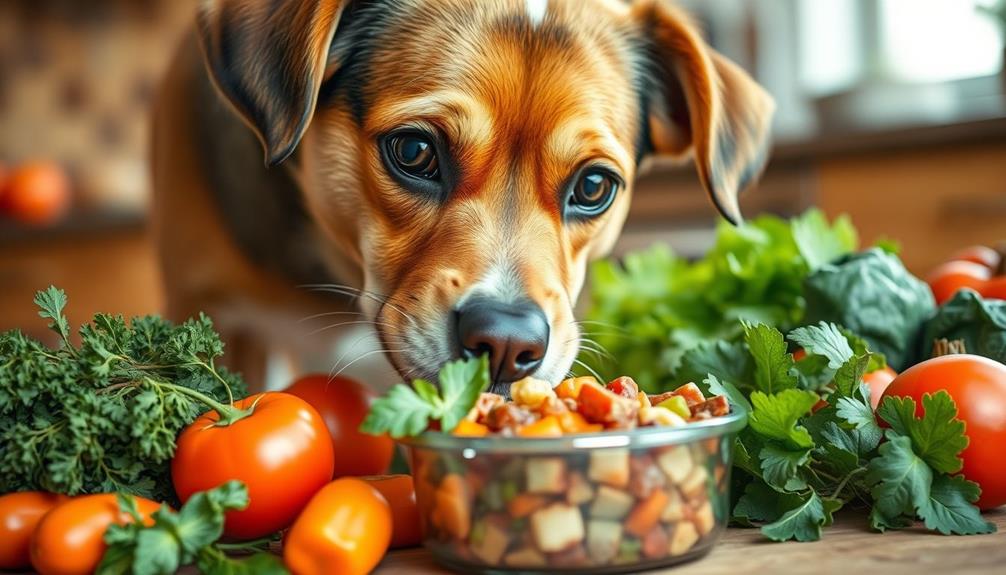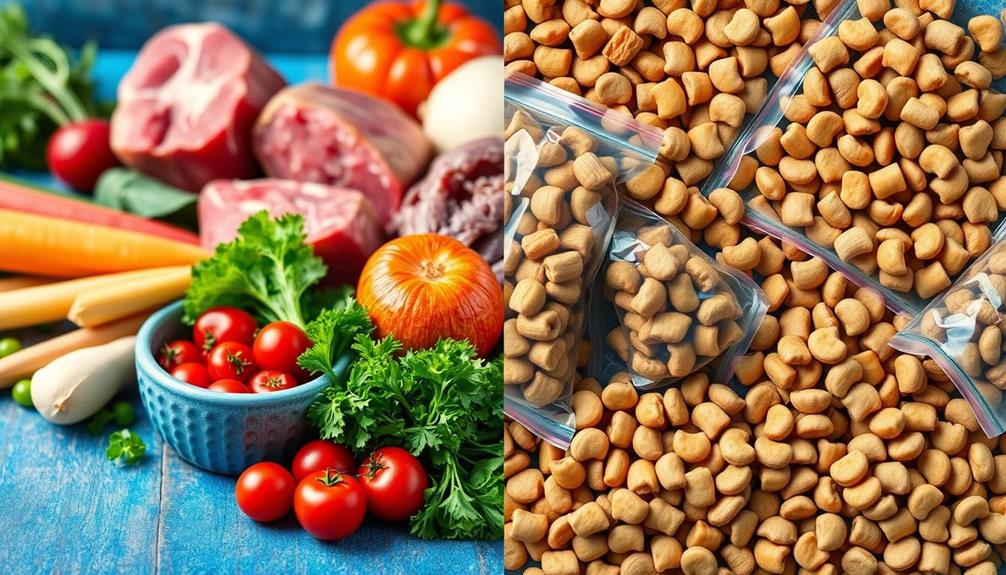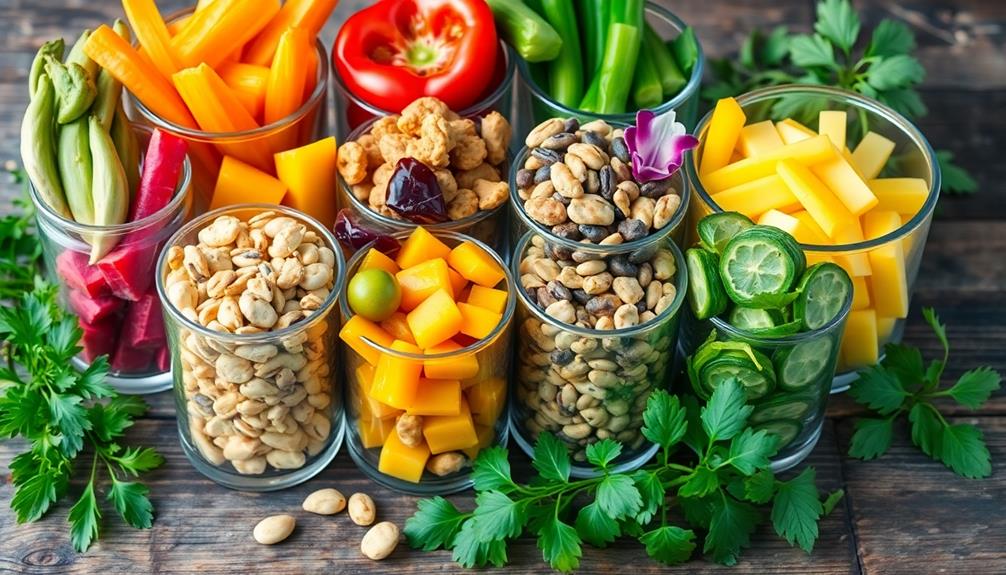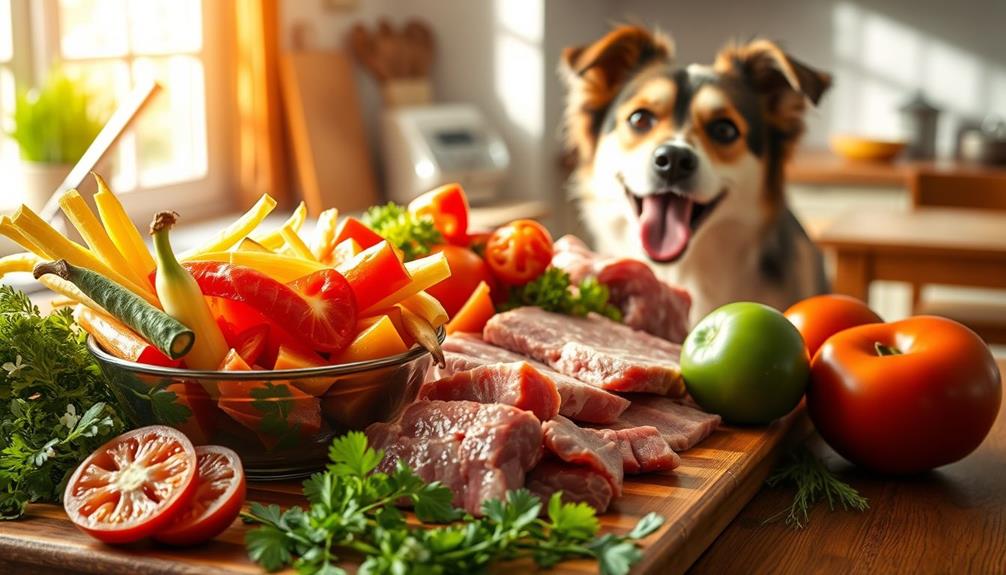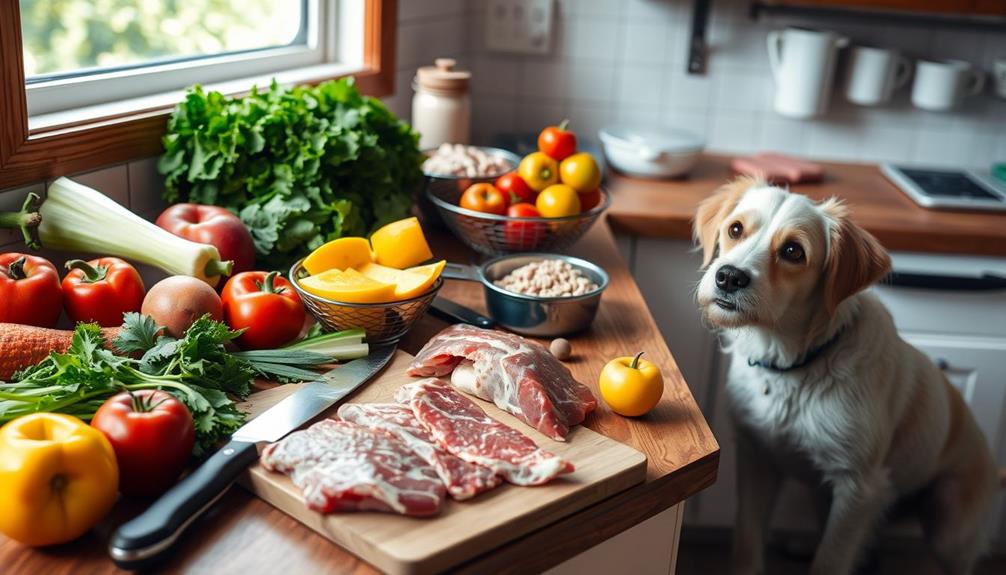Yes, raw food can expose your dog to worms, but it doesn't inherently cause infestations. The key risks are linked to contaminated meat and poor hygiene practices. Raw meat can harbor parasites like roundworms and tapeworms, which can infect your dog if proper precautions aren't taken. To minimize these risks, always source high-quality, human-grade meat, maintain strict hygiene when handling food, and regularly monitor your pet's health. Keeping a clean environment also helps. There's more to learn about protecting your dog from parasites and ensuring a safe raw diet for peak health.
Key Takeaways
- Raw meat can contain harmful parasites, such as roundworms and tapeworms, which pose a risk to dogs if not handled properly.
- The risk of worms is primarily due to contamination rather than raw food itself; sourcing high-quality, human-grade meat reduces this risk.
- Proper hygiene practices, like cleaning up after walks and safe raw meat handling, are essential to prevent worm infestations.
- Regular veterinary checks and fecal analyses are important for early detection and treatment of worm infections in raw-fed dogs.
- A balanced raw diet can enhance gut health, but nutritional deficiencies can increase susceptibility to worms; consultation with a veterinary nutritionist is recommended.
Understanding Worms in Dogs
When it comes to your dog's health, understanding worms is vital. Worms are internal parasites that can wreak havoc on your dog's health, primarily targeting the gastrointestinal tract. You may encounter various types, like roundworms, hookworms, tapeworms, whipworms, and heartworms. Each of these can cause serious issues if left untreated.
Maintaining good hygiene practices, such as regular cleaning of your dog's living area, can help prevent infestations and keep your pet healthy, similar to how proper diet and care are essential for other pets like hamsters.
Common symptoms of worm infestations include digestive disturbances, weight loss, and anemia. In severe cases, they can lead to death. Worms can spread through contaminated soil, water, feces, and infected hosts, which is why regular veterinary checks are important for early detection and treatment.
Your dog might acquire worms by ingesting feces or exploring contaminated environments, making it necessary to maintain good hygiene practices. You should regularly deworm your dog and consult with your veterinarian to keep these internal parasites at bay.
Raw Meat and Parasite Risks
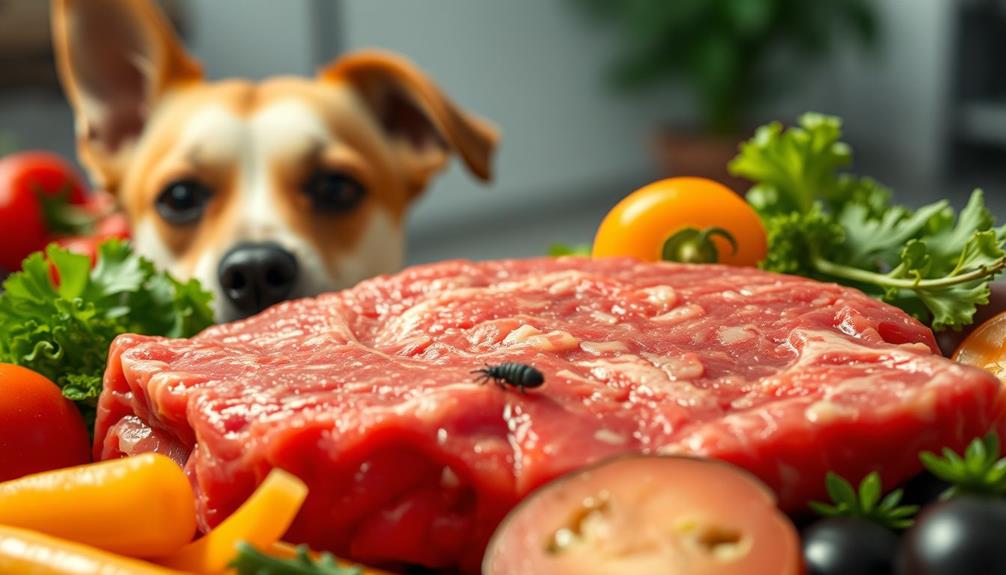
When you're considering raw meat for your dog, it's important to understand the common parasites that can be present.
A well-structured plan for safe feeding practices is essential, similar to how budget management can help maintain financial health. Knowing the transmission pathways helps you take necessary precautions to keep your furry friend safe.
Common Parasite Types
Raw meat can pose certain risks for dogs, particularly through the potential transmission of parasites. Two common types of parasites you should be aware of are roundworms and tapeworms. Roundworms can infect dogs when they ingest eggs from contaminated soil or feces, while tapeworms, like Echinococcus granulosus, can be contracted through consuming infected livestock or raw carcasses.
Additionally, environmental interactions can greatly affect your dog's health and susceptibility to parasites, emphasizing the necessity of maintaining a clean living space and monitoring outdoor areas for contamination. Key Domains of Development in Psychology show that a dog's overall well-being is influenced by various factors, including their diet and environment.
When feeding your dog raw dog food, the risk of parasitic infections is generally low if you use human-grade inspected meat, which undergoes strict monitoring and treatment processes. However, it's vital to note that environmental factors also play a considerable role in the transmission of these parasites. Contaminated soil and feces can be important sources of worms for your dog, not just raw meat consumption.
If your dog has a compromised immune system, such as puppies and older pets, they're at a higher risk for developing worm infestations, regardless of their diet. Keeping an eye on their health and ensuring they receive regular vet check-ups is fundamental for preventing and managing parasite-related issues.
Transmission Pathways Explained
Understanding how parasites transmit is essential for ensuring your dog's health, especially if you're considering a raw diet. Raw food diets can expose your dog to various parasites, including roundworms and tapeworms. However, raw meat isn't the only source of worm infestations. Contaminated environments and feces also play significant roles in transmission.
It's important to select the right food and be aware of cold medications overview when managing your dog's health. For example, about 11% of raw pet food may contain Sarcocystis cruzi, while around 6% could harbor Toxoplasma gondii. Both present health risks not just for your dog but potentially for you as well.
Dogs can acquire worms by ingesting infected feces, so maintaining good hygiene in their environment is essential. Additionally, having a healthy gut microbiome can help your pet fend off infestations, even if they encounter parasites. This highlights the importance of balanced diets that support gut health.
Regular veterinary checks and fecal analyses are critical for early detection of worms, especially for dogs on raw food diets, where these risks may be heightened. By understanding these transmission pathways, you can better protect your furry friend from harmful worm infestations.
Safe Raw Feeding Practices
Feeding your dog a raw diet can be rewarding, but it's vital to implement safe practices to minimize the risk of parasites. Start by sourcing high-quality, human-grade meat, which greatly reduces the chances of worm infestations. Regular veterinary checks and fecal analyses are also important for early detection of potential worm infections, especially in dogs on raw diets.
Additionally, discussing your dog's dietary choices with your vet can help tailor a plan that supports their health and minimizes parasite risks, similar to the importance of mammography guidelines in breast cancer detection.
Always confirm the meat has been properly frozen, as freezing can kill many parasites. When handling raw meat, maintain strict hygiene practices. Wash your hands thoroughly and disinfect surfaces after preparation to prevent cross-contamination.
While dogs have resilient digestive systems, supporting their gut health with balanced diets and supplements can further reduce infection risks. Avoid feeding raw animal parts that are more likely to harbor parasites, like guts or placentas.
Myths About Raw Dog Food
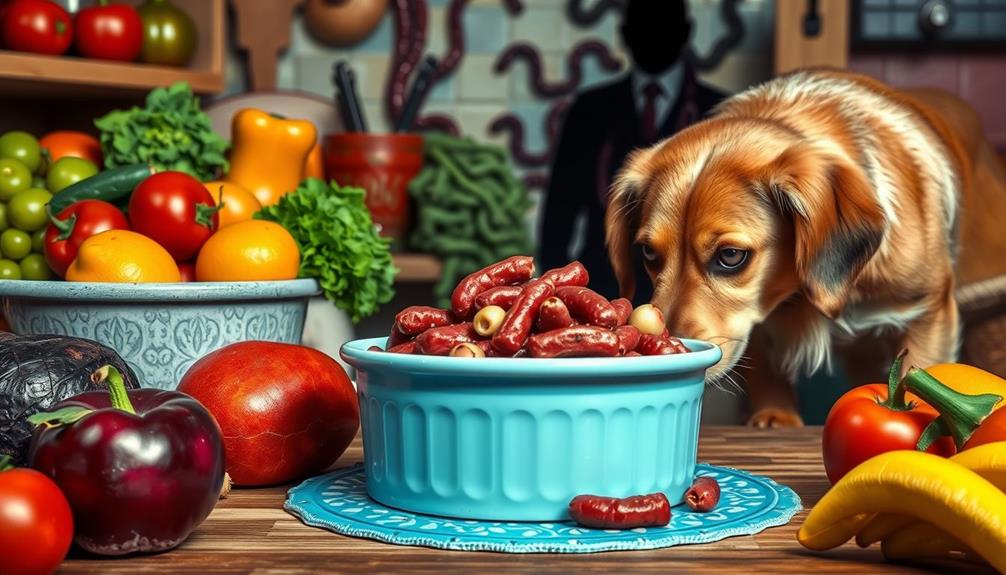
Many pet owners mistakenly believe that raw dog food inevitably leads to worm infestations, but this fear often overlooks vital facts. The primary sources of worms are contaminated environments, not just the raw diet itself. If you're sourcing human-grade inspected meat, you greatly reduce the risk of parasites due to stringent monitoring and treatment processes in place.
Additionally, understanding the various symptoms of emotional dysregulation can help pet owners manage their pet's anxiety related to diet changes. It's essential to recognize that the incidence of parasites in meat is relatively low, especially when you choose reliable suppliers who guarantee proper handling and freezing methods that effectively eliminate potential infestations.
Historically, perceptions of feeding raw as a high-risk practice for worms are often exaggerated. While parasites were once limited to isolated groups, they've spread due to various factors, including hunting and scavenging practices.
Furthermore, awareness about diverse transmission sources of worms—like feces and contaminated soil—is vital. Instead of attributing all risks to feeding raw, educating yourself about these factors will help you make informed decisions for your pet's health.
Understanding these myths can empower you to embrace a raw diet confidently, knowing you're providing nutritious food without unnecessary fears.
Preventing Worm Infestations
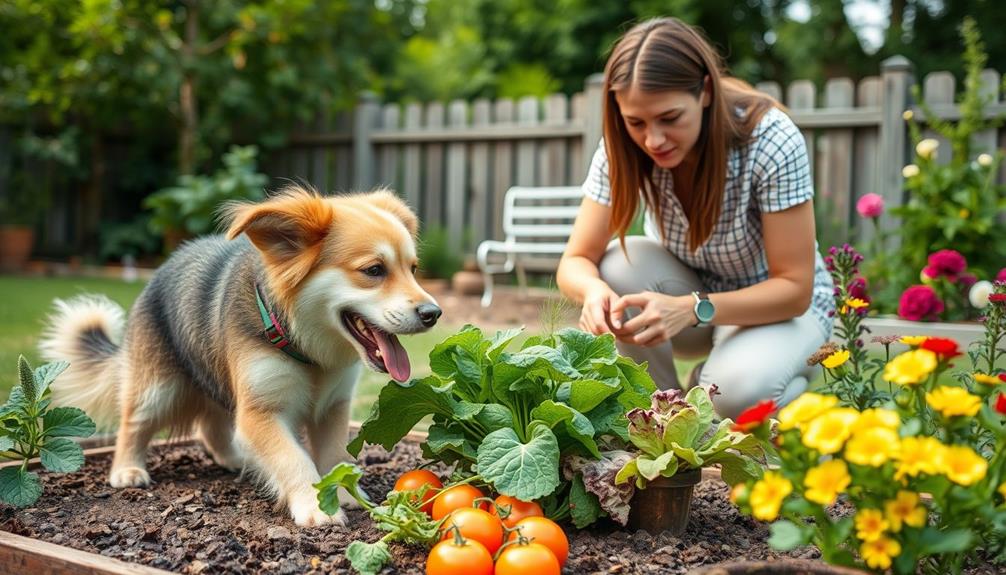
Preventing worm infestations in dogs involves proactive measures that every pet owner can take. By staying vigilant and implementing the right practices, you can greatly reduce the risk of your dog getting worms. Here are some essential tips you should follow:
| Action | Purpose | Frequency |
|---|---|---|
| Inspect feces | Early detection of worms | Daily |
| Clean up promptly | Minimize bacteria and parasites | After every walk |
| Source raw food wisely | Guarantee safe meat | Every purchase |
Regularly inspecting your dog's feces can help you catch any signs of worms early on, allowing for prompt treatment. Maintaining a clean environment by cleaning up after your dog and avoiding contaminated surfaces is vital. Always source raw pet food from reputable suppliers, confirming the meat has been frozen to eliminate potential parasites.
Additionally, good hygiene practices like washing your hands and disinfecting surfaces after handling raw food can reduce the risk of transmitting bacteria and parasites. Finally, consult your veterinarian for a tailored deworming schedule and preventive medication to keep your furry friend healthy and worm-free.
Signs of Worm Infections
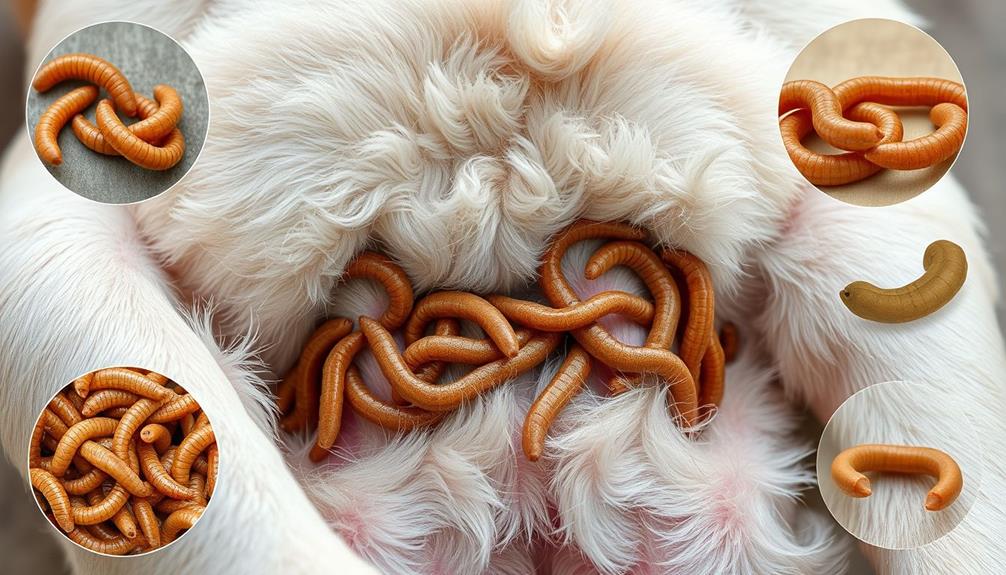
If you notice visible worms in your dog's feces or around their rear end, it's a clear sign of a worm infection that needs attention.
Regular check-ups with a veterinarian can help catch these issues early and guarantee financial considerations for elderly care aren't overlooked.
You should also watch for digestive distress symptoms like diarrhea and vomiting, which can indicate that your dog is struggling with intestinal worms.
Keeping an eye on these signs helps guarantee your furry friend stays healthy and happy.
Visible Worms in Feces
Finding visible worms in your dog's feces can be alarming, and it's a clear sign that something's wrong. Commonly, you might notice small, white, rice-like segments, which are tapeworms, or long, spaghetti-like strands, which are roundworms. These visible worms in feces indicate a worm infection that needs urgent attention.
Regular veterinary check-ups can help in identifying any underlying issues, similar to how proper piercing care and hygiene are essential for preventing complications in body piercings.
It's important to regularly inspect your dog's feces. Early detection can make a big difference in treatment and prevent further complications. If you spot these worms, don't wait—consult your veterinarian right away. They can perform a fecal analysis to identify the specific type of worms, even if some aren't visible to the naked eye.
While dogs are often the focus, it's worth noting that cats can also experience similar worm infections. Keeping an eye on both dogs and cats helps guarantee their health and wellbeing.
Digestive Distress Symptoms
Digestive distress symptoms in dogs can be alarming and often indicate a worm infection. If your dog is experiencing issues like vomiting, diarrhea, or significant weight loss, it's essential to pay attention. These signs could mean your furry friend is battling a parasitic infestation.
You might also notice lethargy, which can further signal a problem. Additionally, using natural remedies like essential oils can support overall wellness, although they shouldn't replace veterinary care; for instance, essential oils for digestive health can complement your dog's care.
A sudden change in appetite—either a lack of interest in food or increased hunger—can occur as worms consume the nutrients your dog needs. Additionally, look out for pale gums or weakness, as these symptoms could indicate anemia from blood loss, particularly due to hookworms.
If you see visible worms in your dog's feces or around the anus, this is a clear indication that veterinary attention is necessary. Regular fecal examinations can be beneficial, as some microscopic parasites may not show immediate digestive distress symptoms but can still lead to health issues over time.
Keep an eye on your dog's behaviors and health. Early detection of worm infections can make a notable difference in treatment and recovery. Always consult your veterinarian if you suspect your dog is experiencing digestive distress.
Diagnosing Worms in Pets
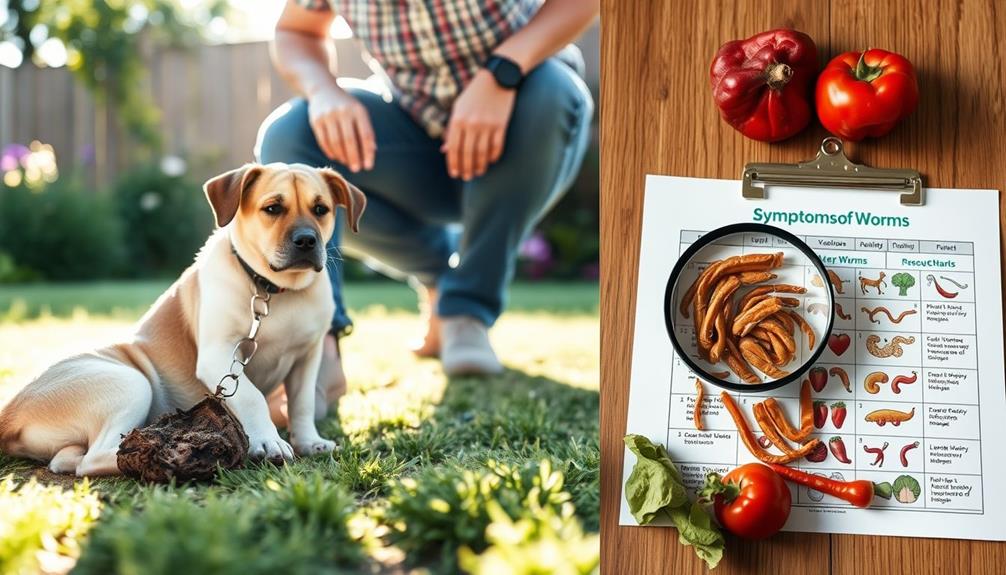
When you notice any unusual signs in your pet, such as changes in appetite or weight loss, it's important to contemplate the possibility of worms.
Diagnosing worms in pets involves a few vital steps to guarantee your furry friend gets the help they need. If your pet is on a raw feeding diet, you should be particularly vigilant.
Understanding the financial implications of caring for a pet with health issues can also help you prepare for potential veterinary expenses.
Here are four key steps to help you diagnose worms in your pet:
- Regularly inspect feces: Look for any visible signs of worms or eggs. Early detection is essential.
- Consult a veterinarian: If you spot any unusual signs, prompt consultation is important to avoid complications.
- Fecal analysis: Your vet can perform a detailed analysis to identify microscopic parasites that you mightn't see.
- Maintain a health log: Keeping a record of your pet's fecal health will help track changes and identify any infestations over time.
Taking these steps can greatly aid in diagnosing worms in pets and guarantee that your pet remains healthy, especially if they're on a raw food diet.
Treating Worm Infestations
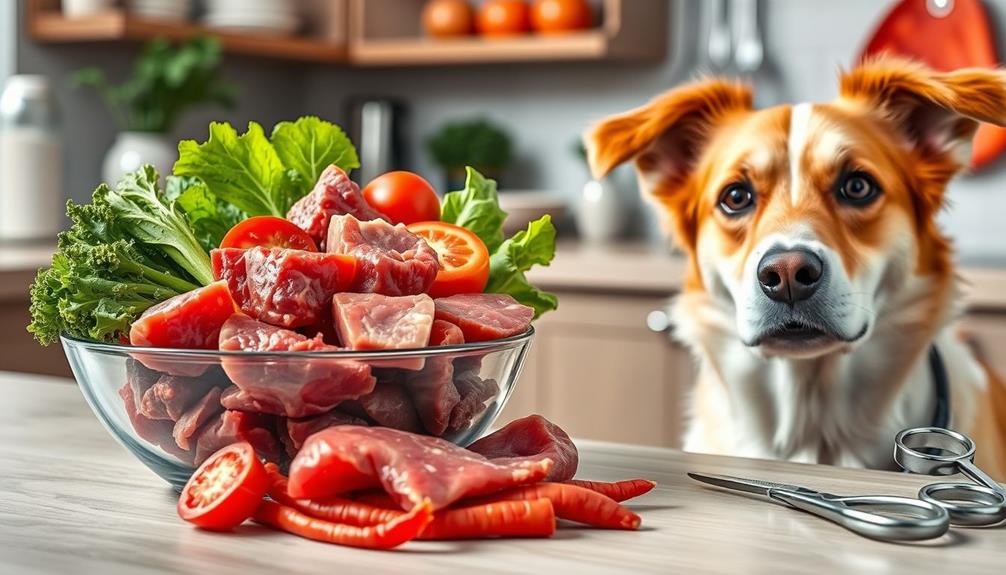
Treating worm infestations in dogs involves a straightforward approach that combines veterinary guidance with appropriate medications. Your vet will likely recommend specific deworming medications tailored to the type of worms affecting your dog, such as roundworms, tapeworms, or hookworms. These medications can come in tablet or liquid forms.
It's vital to have regular fecal analyses performed by your veterinarian. This helps identify the type of worm present and guarantees the treatment plan is effective. If your dog is on a raw diet, you might need to schedule more frequent deworming treatments due to potentially higher exposure to parasites.
While traditional treatments are essential, some natural remedies, like pumpkin seeds and diatomaceous earth, can complement your dog's care. Just make sure to discuss these with your vet to confirm they're safe and effective, especially if your dog has a compromised immune system.
After completing the treatment, a follow-up fecal test is important. This will confirm whether the worms have been successfully eliminated and help you adjust future deworming schedules based on your dog's specific needs.
Dietary Impact on Health
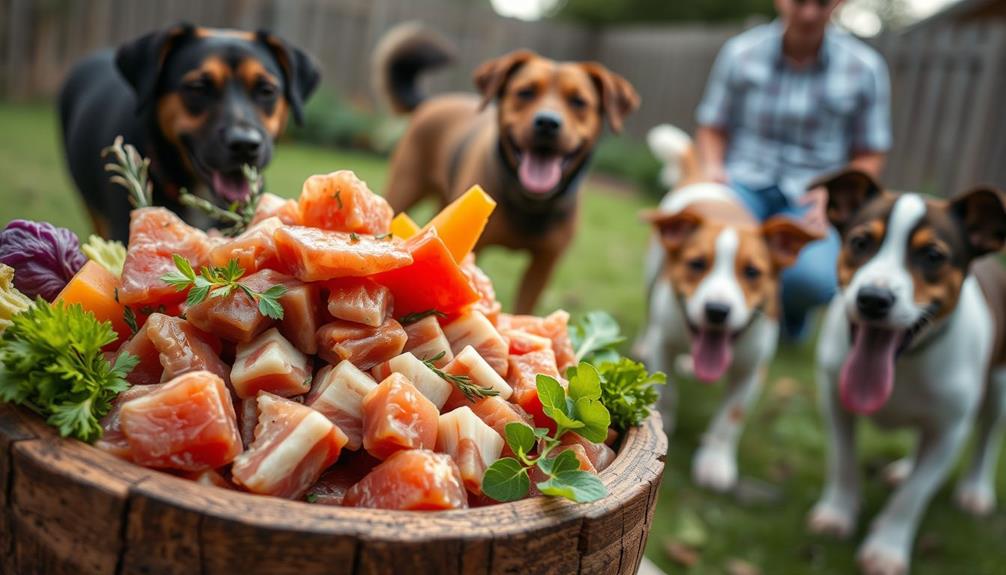
When you choose a raw diet for your dog, you're not just opting for something trendy; you're investing in their nutritional balance.
A well-rounded diet enhances gut health, which in turn supports a stronger immune system.
Nutritional Balance Importance
A balanced diet is vital for your dog's health and well-being, directly impacting their immune function and overall energy.
When considering raw pet food, it's important to guarantee it meets all nutritional requirements. Otherwise, your dog may face serious health risks, including increased susceptibility to worms.
Here are some key points to keep in mind:
- Nutritional Deficiencies: Raw diets may lack important macro- and micro-nutrients, which can weaken your dog's immune system.
- Gastrointestinal Issues: Inadequate nutrition can lead to gastrointestinal problems, further compromising your dog's ability to fend off infections.
- Veterinary Guidance: Consulting a veterinary nutritionist is recommended to guarantee your raw pet food provides the necessary nutritional balance.
- Commercial Safety: Commercially prepared dog food is generally safer, as it's formulated to meet all nutritional needs, reducing health risks associated with raw feeding.
Gut Health Enhancement
Gut health plays a significant role in your dog's overall well-being, particularly in their ability to fend off infections and maintain a strong immune system. A balanced raw diet can enhance gut health by promoting a diverse gut microbiome, which is essential for boosting immunity against parasites.
When your dog has a healthy gut microbiome, they're better equipped to fend off potential worm infections, even when exposed to parasites.
To optimize gut terrain, consider incorporating natural supplements, such as probiotics and prebiotics. These can impact pH levels and microbiome diversity, supporting digestive health further.
Regularly rotating food and supplements encourages the growth of beneficial gut bacteria, which contributes to a stronger immune response in your pet.
Holistic nutrition emphasizes the importance of a natural and balanced diet that supports gut health. By focusing on these aspects, you'll enhance your pet's resistance to parasitic infestations.
Immune System Support
To support your dog's immune system effectively, it's vital to recognize the impact of diet on their health. A balanced raw diet can greatly enhance gut health, which is important for robust immune system support.
When your dog's gut microbiome thrives, they're better equipped to fend off infections, including parasites.
Here are four ways raw foods can boost your dog's immune system:
- Diverse Protein Sources: Regularly rotating protein sources in their raw diet helps maintain a rich gut flora, supporting a strong immune response.
- Gut Microbiome Diversity: Nutritional supplements that promote gut microbiome diversity can enhance your dog's resistance to parasitic infections.
- Improved Gut Health: A healthy gut leads to better immunity, making your dog less likely to suffer severe consequences from potential worm exposure.
- Natural Defense: With a strong immune system, your dog can effectively combat infections, minimizing the risk of worm infestations even when exposed to parasites.
Best Practices for Raw Feeding
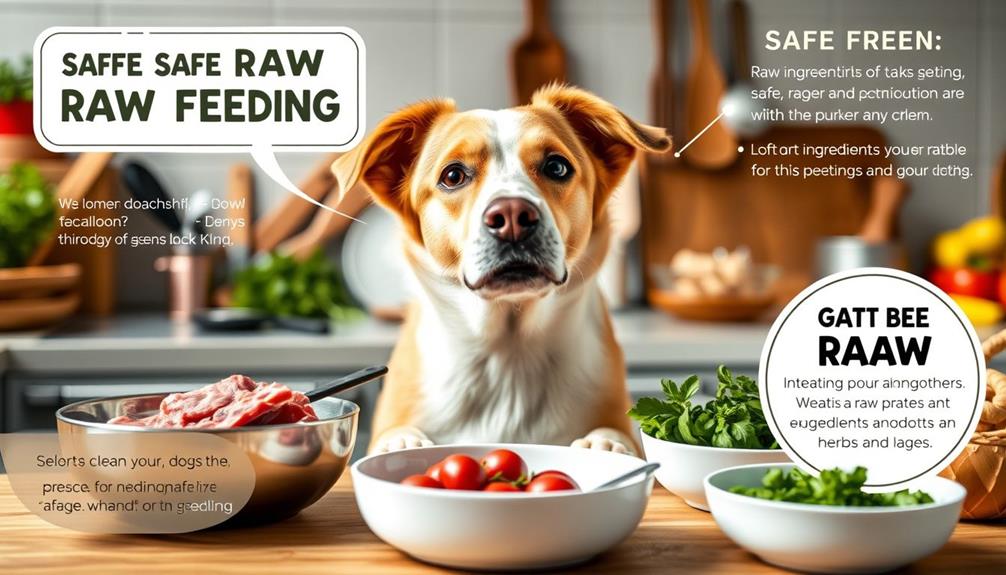
Guaranteeing your dog's health and safety while raw feeding requires careful attention to best practices for raw feeding. Start by choosing high-quality, human-grade raw food from reputable suppliers. This minimizes the risk of parasites and guarantees proper inspection for harmful bacteria.
It's imperative to maintain strict hygiene practices—wash your hands thoroughly and disinfect surfaces to prevent cross-contamination when handling raw meat. Store raw food in the freezer until you're ready to use it, and always thaw it safely in the refrigerator or microwave. This helps eliminate potential parasites that thrive in warmer temperatures.
Additionally, avoid feeding your dog raw parts that may harbor infections, like animal guts or placentas, as these could increase the risk of worm exposure. Regularly monitor your dog's health and behavior, noting any changes.
It's important to consult with a veterinarian to guarantee that your dog's raw diet is balanced and free from potential worm infestations. By following these best practices for raw feeding, you can help keep your furry friend healthy and safe.
Holistic Approaches to Deworming
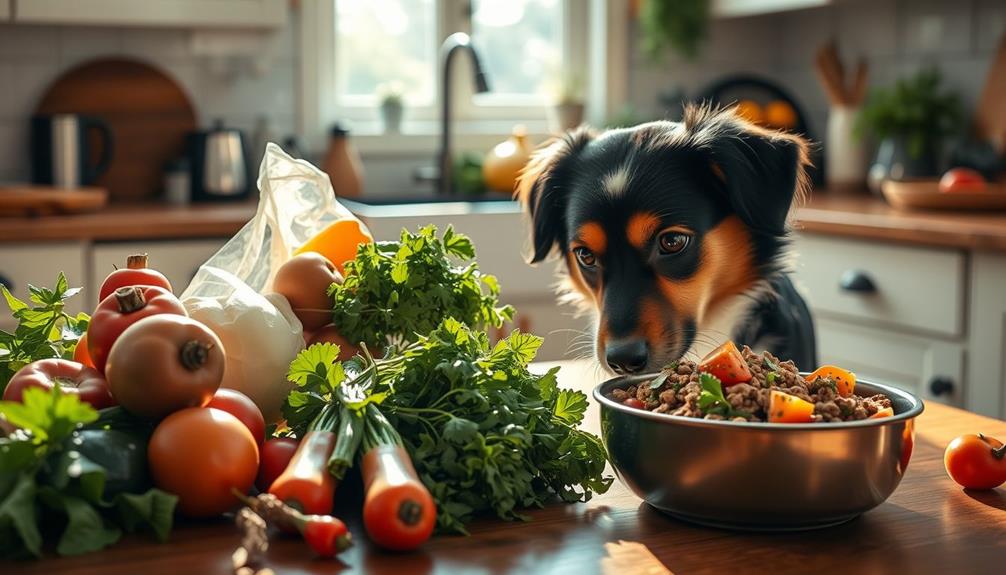
When considering deworming your dog, holistic approaches offer natural alternatives that can complement traditional methods. These methods focus on enhancing pet health and preventing worm infestations through natural remedies. Here are some holistic options you might explore:
- Pumpkin Seeds: These contain compounds that may help expel intestinal worms.
- Ground Carrots: Rich in fiber, they can assist in cleansing the digestive tract.
- Diatomaceous Earth: This natural substance can potentially kill parasites without harming your dog.
- Balanced Diet: Maintaining a strong immune system through holistic nutrition can reduce the likelihood of infestations.
Before starting any deworming treatment, regular fecal testing is vital to confirm the presence of worms.
While holistic treatments can supplement conventional methods, it's important to consult with your veterinarian to guarantee their safety and effectiveness.
Remember, overusing medications can lead to antibiotic resistance and harm beneficial gut bacteria, making these holistic approaches appealing for many pet owners.
Frequently Asked Questions
Does Raw Diet Give Dog Worms?
A raw diet doesn't directly give your dog worms, but it can expose them to parasites. You need to guarantee high-quality meat and maintain hygiene to minimize the risk of contamination and worm transmission. Raw diets for dogs have become increasingly popular in recent years, but it’s important for pet owners to understand the potential risks of feeding raw. In addition to the risk of parasites, raw diets can also lead to imbalanced nutrition and the potential for bacterial contamination. It’s crucial to do thorough research and consult with a veterinarian before deciding to transition your dog to a raw diet to ensure their health and safety.
Why Don't Vets Recommend a Raw Diet?
Imagine feeding your dog a feast fit for a caveman, but vets don't recommend raw diets due to contamination risks, nutrient imbalances, and potential health threats to both pets and their human companions.
Can Dog Food Give Dogs Worms?
Dog food itself isn't the primary source of worms for dogs. Contaminated environments, fecal matter, and infected prey pose greater risks. Regular vet checks and good hygiene can help keep your dog healthy and worm-free.
Can Dogs Get Tapeworms From Eating Raw?
You might think raw food is safe, but dogs can get tapeworms from it. If you feed your dog raw meat, guarantee it's sourced properly to minimize this risk, and keep up with regular vet check-ups.
Conclusion
In the world of dog nutrition, raw food can be a double-edged sword. While it offers benefits, it also opens the door to potential worm infestations. Think of it as walking a tightrope—balance is key. By staying informed and adopting best practices, you can keep your furry friend healthy and worm-free. Remember, a well-fed dog is like a well-tended garden, thriving when given the right care and attention. So, equip yourself with knowledge and nurture your pup's well-being!

